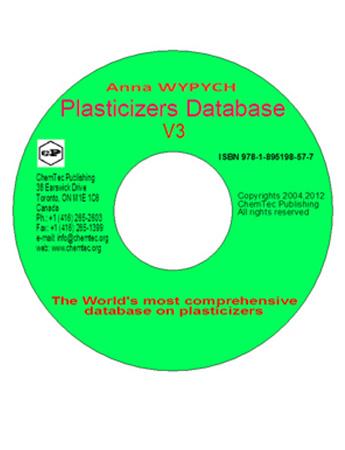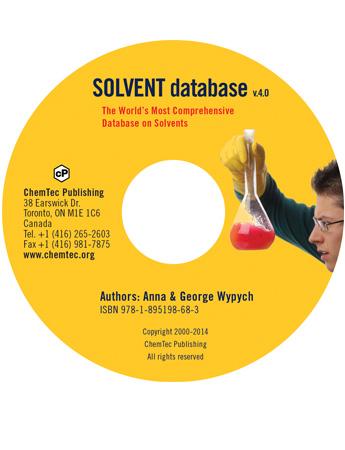Antistatics Database, 2nd Edition
During the time since the first edition in 2007, many changes occurred in the market resulting in the elimination of a large number of additives and introduction of new products. These changes are recorded in the database, which contains an actual range of used compounds. The Antistatics Database is divided into five sections: General information, Physical properties, Health and safety, Ecological properties, and Use & Performance. Information on the selected additive can be accessed by clicking on any of the above tabs. The database has 130 data fields to accommodate a variety of data available in source publications. The description of general sections below gives more detail on the composition of information. The displayed information contains an additive name and its chemical structure (if it is a single compound disclosed by the manufacturer). The data can be viewed on screen and printed in a predefined format.
In General information section the following data are displayed: name, CAS #, IUPAC name, Common name, Common synonym, Acronym, Empirical formula, Molecular weight, Chemical category, Mixture, Product contents, Moisture content, Silicone content, and EC number
Physical properties section contains data on State, Odor, Color (Gardner and Platinum-cobalt scales), Boiling point, Melting point, Freezing point, Pour point, Iodine value, Particle diameter, Particle length, Surface area (BET), Refractive index, Specific gravity, Density, Bulk density, Vapor density, Vapor pressure, pH, Saponification value, Acidity, Viscosity, Kinematic viscosity, Melt index, Surface tension, Solubility in water and solvents, Thermal expansion coefficient, Heat of combustion, Specific heat, Thermal conductivity, Volatility, Volume resistivity, Surface resistivity, Surface resistance, Static decay time, Dielectric constant, Ash contents, Mold shrinkage, Impact strength, Tensile strength, Tensile elongation, Tensile modulus, Flexural strength, Flexural modulus, Drying time, Drying temperature
Health and safety section contains data on Flash point, Flash point method, Autoignition temperature, Explosive LEL, Explosive UEL, NFPA Classification, NFPA Health, NFPA Flammability, NFPA Reactivity, HMIS Classification, HMIS Health, HMIS Fire, HMIS Reactivity, HMIS Personal protection, UN Risk Phrases, R, UN Safety Phrases, S, DOT Hazard Class, UN/NA, ICAO/IATA Class, IMDG Class, TDG class, Proper shipping name, Food law approvals, Rat oral LD50, Mouse oral LD50, Rabbit dermal LD50, Inhalation rat LC50, Skin irritation, Eye irritation (human), Ingestion, First aid: eyes, skin, and inhalation, Chronic effects, Carcinogenicity, Mutagenicity, and TLV - TWA 8h (ACGIH, NIOSH, OSHA)
Ecological properties section contains data on Biological Oxygen Demand, Biodegradation probability, Aquatic toxicity LC50 (Rainbow trout, Bluegill sunfish, Fathead minnow, and Daphnia magna), Partition coefficients (log Koc, log Kow)
Use & performance section contains information on Manufacturer, Outstanding properties, Recommended for polymers, Recommended for products, Features & benefits, Processing methods, Additive application method, Recommended dosage, Davies scale, Concentration of active ingredients, Carrier resin
Search is a simple process which can be done in several ways. The most common is to search name. In this case, the program searches through the list of synonyms and proposes choices. Search permits finding antistatics by typing the first letter or two of their name which moves list to the location of a searched compound. Antistatics can also be searched by CAS number, empirical formula, or any other property, or simply by browsing the list. In addition to searching capability and viewing data on individual antistatics, antistatics can be sorted according to values of any property. This operation is accomplished by clicking the property tab and selection of the required search term from a pull-down menu. The operation returns a selection of antistatics for which data exist for the selected property. The antistatics properties can be viewed on the screen and used for evaluation of its suitability for the chosen task or its selection for application as well as for comparison with other products.
The above description shows that operation of the database is so simple that it does not require any computer skills. The appropriate computer for database use is a PC-based computer with Pentium processor (or other processors of similar speed) having a screen with the resolution of at least 600 by 800 operating under Windows NT or higher (including Windows 8). The program contains operation manual which explains further details of the operation. In summary, the database is a very powerful tool, because it contains the most extensive data available on a large number of antistatics. The database is an excellent companion to the Handbook of Antistatics because data in the database do not repeat information or data included in the book. The number of data currently available makes a presentation of the data in the traditional format of a printed book unsuitable for fast accessing of the information and in this case difficult to handle.
An overview of nanotechnology that encompasses scientific, technological, economic and social issues – investigating the potential of nanotechnology to transform whole sectors of industry from healthcare to energy. Jeremy Ramsden provides a blueprint for those involved in the commercialization of nanotechnology.
In Applied Nanotechnology Professor Ramsden takes an integrated approach to the scientific, commercial and social aspects of nanotechnology, exploring:
In General information section the following data are displayed: name, CAS #, IUPAC name, Common name, Common synonym, Acronym, Empirical formula, Molecular weight, Chemical category, Mixture, Product contents, Moisture content, Silicone content, and EC number
Physical properties section contains data on State, Odor, Color (Gardner and Platinum-cobalt scales), Boiling point, Melting point, Freezing point, Pour point, Iodine value, Particle diameter, Particle length, Surface area (BET), Refractive index, Specific gravity, Density, Bulk density, Vapor density, Vapor pressure, pH, Saponification value, Acidity, Viscosity, Kinematic viscosity, Melt index, Surface tension, Solubility in water and solvents, Thermal expansion coefficient, Heat of combustion, Specific heat, Thermal conductivity, Volatility, Volume resistivity, Surface resistivity, Surface resistance, Static decay time, Dielectric constant, Ash contents, Mold shrinkage, Impact strength, Tensile strength, Tensile elongation, Tensile modulus, Flexural strength, Flexural modulus, Drying time, Drying temperature
Health and safety section contains data on Flash point, Flash point method, Autoignition temperature, Explosive LEL, Explosive UEL, NFPA Classification, NFPA Health, NFPA Flammability, NFPA Reactivity, HMIS Classification, HMIS Health, HMIS Fire, HMIS Reactivity, HMIS Personal protection, UN Risk Phrases, R, UN Safety Phrases, S, DOT Hazard Class, UN/NA, ICAO/IATA Class, IMDG Class, TDG class, Proper shipping name, Food law approvals, Rat oral LD50, Mouse oral LD50, Rabbit dermal LD50, Inhalation rat LC50, Skin irritation, Eye irritation (human), Ingestion, First aid: eyes, skin, and inhalation, Chronic effects, Carcinogenicity, Mutagenicity, and TLV - TWA 8h (ACGIH, NIOSH, OSHA)
Ecological properties section contains data on Biological Oxygen Demand, Biodegradation probability, Aquatic toxicity LC50 (Rainbow trout, Bluegill sunfish, Fathead minnow, and Daphnia magna), Partition coefficients (log Koc, log Kow)
Use & performance section contains information on Manufacturer, Outstanding properties, Recommended for polymers, Recommended for products, Features & benefits, Processing methods, Additive application method, Recommended dosage, Davies scale, Concentration of active ingredients, Carrier resin
Search is a simple process which can be done in several ways. The most common is to search name. In this case, the program searches through the list of synonyms and proposes choices. Search permits finding antistatics by typing the first letter or two of their name which moves list to the location of a searched compound. Antistatics can also be searched by CAS number, empirical formula, or any other property, or simply by browsing the list. In addition to searching capability and viewing data on individual antistatics, antistatics can be sorted according to values of any property. This operation is accomplished by clicking the property tab and selection of the required search term from a pull-down menu. The operation returns a selection of antistatics for which data exist for the selected property. The antistatics properties can be viewed on the screen and used for evaluation of its suitability for the chosen task or its selection for application as well as for comparison with other products.
The above description shows that operation of the database is so simple that it does not require any computer skills. The appropriate computer for database use is a PC-based computer with Pentium processor (or other processors of similar speed) having a screen with the resolution of at least 600 by 800 operating under Windows NT or higher (including Windows 8). The program contains operation manual which explains further details of the operation. In summary, the database is a very powerful tool, because it contains the most extensive data available on a large number of antistatics. The database is an excellent companion to the Handbook of Antistatics because data in the database do not repeat information or data included in the book. The number of data currently available makes a presentation of the data in the traditional format of a printed book unsuitable for fast accessing of the information and in this case difficult to handle.
An overview of nanotechnology that encompasses scientific, technological, economic and social issues – investigating the potential of nanotechnology to transform whole sectors of industry from healthcare to energy. Jeremy Ramsden provides a blueprint for those involved in the commercialization of nanotechnology.
In Applied Nanotechnology Professor Ramsden takes an integrated approach to the scientific, commercial and social aspects of nanotechnology, exploring:
- The relationship between nanotechnology and innovation
- The changing economics and business models required to commercialize innovations in nanotechnology
- Product design challenges - investigated through case studies
- Applications in various sectors, including composite materials, energy, and agriculture
- The role of government in promoting nanotechnology
- The potential future of molecular self-assembly in industrial production
- The ethics and social implications of nanotechnology
As well as providing business models and practical examples of the innovation process, this book offers a vision of the role of nanotechnology in confronting the challenges facing humanity, from healthcare to climate change.
George Wypych has a Ph. D. in chemical engineering. His professional expertise includes both university teaching (full professor) and research & development. He has published 17 books: PVC Plastisols, (University Press); Polyvinylchloride Degradation, (Elsevier); Polyvinylchloride Stabilization, (Elsevier); Polymer Modified Textile Materials, (Wiley & Sons); Handbook of Material Weathering, 1st, 2nd, 3rd, and 4th Editions, (ChemTec Publishing); Handbook of Fillers, 1st, 2nd and 3rd Editions, (ChemTec Publishing); Recycling of PVC, (ChemTec Publishing); Weathering of Plastics. Testing to Mirror Real Life Performance, (Plastics Design Library), Handbook of Solvents, Handbook of Plasticizers, Handbook of Antistatics, Handbook of Antiblocking, Release, and Slip Additives (1st and 2nd Editions), PVC Degradation & Stabilization, PVC Formulary, Handbook of UV Degradation and Stabilization, Handbook of Biodeterioration, Biodegradation and Biostabilization, and Handbook of Polymers (all by ChemTec Publishing), 47 scientific papers, and he has obtained 16 patents. He specializes in polymer additives, polymer processing and formulation, material durability, and the development of sealants and coatings. He is included in the Dictionary of International Biography, Who's Who in Plastics and Polymers, Who's Who in Engineering, and was selected International Man of the Year 1996-1997 in recognition for his services to education.



